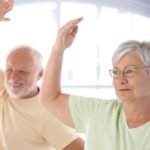Article Summary:
- According to new research, dancing might be one of the best ways to stay healthy as you age.
- Volunteers who danced regularly had a whopping 73 percent lower risk of disability than those who did not dance.
- It is a great physical workout that builds balance, muscle strength, and improves endurance and cognition.
Do You Love To Dance? Don’t Stop!
Are you the type who will start dancing around the kitchen as you are cooking if a good song comes on the radio? Or maybe you’re the first one on the dance floor when you’re at a wedding and the band starts playing. If you love music and can’t keep your body from moving to the rhythm, you should encourage yourself to keep up this behavior and start making it a regular habit. According to new research, dancing might be one of the best ways to stay healthy as you age.
The study, which took place at the Tokyo Metropolitan Institute of Gerontology in Japan, found that dancing may reduce the risk of experiencing disabilities later in life, helping people remain healthier and more active in general.1 Osuka, Yosuke; et al. “Exercise type and activities of daily living disability in older women: An 8-year population-based cohort study.” Scandinavian Journal of Medicine & Science in Sports. 18 December 2018. Accessed 23 December 2018. http://onlinelibrary.wiley.com/doi/abs/10.1111/sms.13336. These results are based on an investigation that included 1,003 older Japanese women who had no problems achieving typical activities of daily living as the trial began.
Research on Health Benefits of Dancing
The subjects were interviewed about their regular activity and answered questions about whether they take part in 16 specific types of exercise. They were then tracked for a period of eight years and evaluated for instances of an impaired ability to perform one or more daily living tasks. These activities included walking, eating, bathing, dressing, and using a toilet independently.
A disability in at least one area was assessed in 130 of the participants during the study period. But when the investigators compared health records against the women’s reported exercise routines, they discovered that keeping active in any way—which included undeniably beneficial workouts such as walking, yoga, and doing calisthenics—helped reduce the chance of developing a disability.
But far and away, the greatest difference was linked to dancing. Volunteers who danced regularly had a whopping 73 percent lower risk of disability than those who did not dance. And this association held up even after the researchers controlled for potential influencing factors.
Why Dancing is The Health Winner of All Physical Activity
Why might dancing be a key to better maintenance of our ability to perform daily living tasks as we age? The answer isn’t clear, but the investigators theorize that it could be related to the variety of skill sets that are required for dancing. It is a great physical workout that builds balance, muscle strength, and improves endurance. At the same time, there is a mental aspect to dancing that may be equally important. It requires the adaptability to change movements along with the rhythm and a partner, concentration to execute certain movements correctly, and memory skills for remembering the specifics of choreography.
And speaking of the cognitive benefits of dancing, a new study at Guangzhou University of Chinese Medicine in China showed that mind-body activities, such as dancing, tai chi, and yoga, can strengthen certain mental abilities.2 Wu, Chunxiao; et al. “Effects of Mind-Body Exercises on Cognitive Function in Older Adults: A Meta-Analysis.” Journal of the American Geriatrics Society. 18 December 2018. Accessed 24 December 2018. http://onlinelibrary.wiley.com/doi/abs/10.1111/jgs.15714.
The focus was on global cognition, which involves planning, decision-making, and other aspects of executive function. Just one to two hours of mind-body activities weekly were found to improve cognition, even among the subjects who had begun to experience some decline.
While the studies described above did not prove cause and effect, both offer evidence of the wide-ranging benefits of dancing. And they are in line with earlier research, such as a 2011 study at Geneva University Hospitals in Switzerland that showed exercising to music improves balance in the elderly.
So, if you love to dance, commit to making it part of your exercise routine. When we find activities we really enjoy participating in, we are much more likely to stick with them long-term and reap their benefits. If you haven’t spent much time dancing since ballet for beginners in second grade, or perhaps never, it might be worth your while to give it a try. Many dance schools have classes for adults in all kinds of genres, so peruse the offerings and pick one that seems the most appealing. And many classes can be offered online, allowing you to dance safely in your own home. So, put on your dancing shoes and get going!
References
| ↑1 | Osuka, Yosuke; et al. “Exercise type and activities of daily living disability in older women: An 8-year population-based cohort study.” Scandinavian Journal of Medicine & Science in Sports. 18 December 2018. Accessed 23 December 2018. http://onlinelibrary.wiley.com/doi/abs/10.1111/sms.13336. |
|---|---|
| ↑2 | Wu, Chunxiao; et al. “Effects of Mind-Body Exercises on Cognitive Function in Older Adults: A Meta-Analysis.” Journal of the American Geriatrics Society. 18 December 2018. Accessed 24 December 2018. http://onlinelibrary.wiley.com/doi/abs/10.1111/jgs.15714. |











